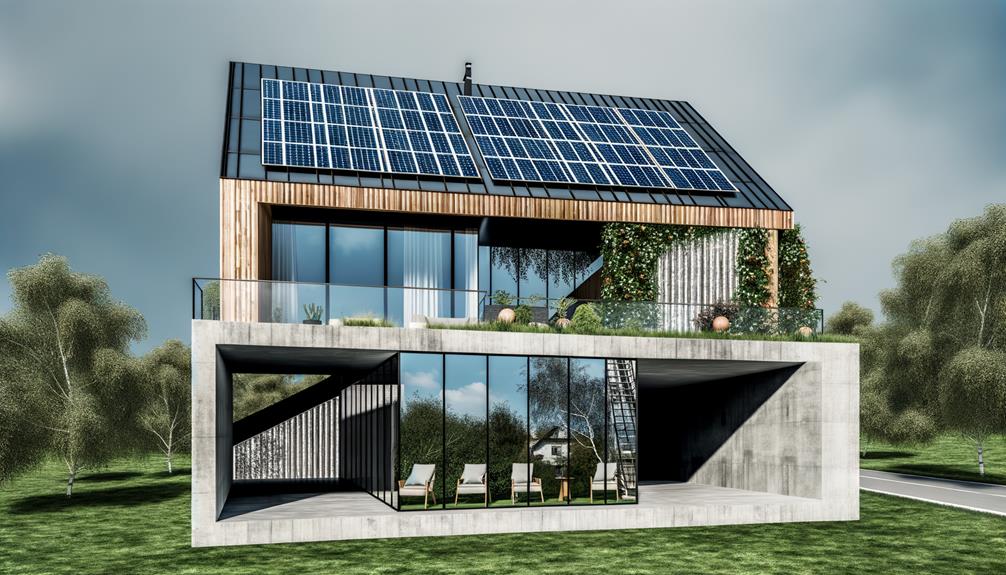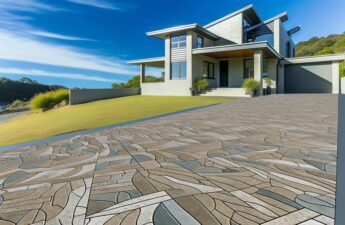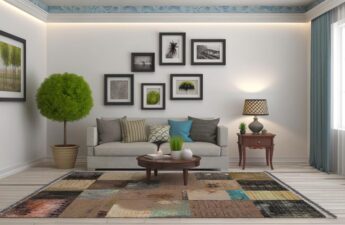Step into the world of sustainable and eco-friendly materials. Modern house design takes on a whole new shade of green. Imagine a palette of bamboo, cork, hempcrete, and recycled steel. These materials blend together to create a harmonious symphony of style and sustainability.
As you explore the possibilities, you'll discover not only the environmental benefits of these materials but also their durability, insulation properties, and aesthetic appeal. Sustainable materials are not only good for the planet but also offer practical advantages.
So, get ready to embark on a journey where innovation meets conscientious construction. The future of housing is as eco-friendly as it is beautiful. By embracing sustainable materials, we can create homes that are both stylish and environmentally responsible.
Recycled Steel and Wood
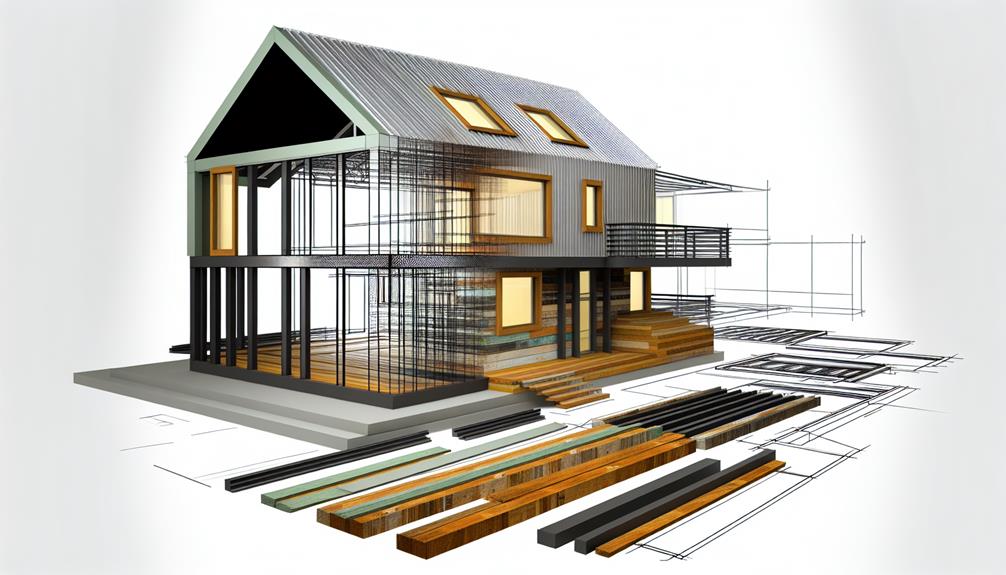
Recycled steel and wood are essential eco-friendly materials that can significantly enhance the sustainability of modern house design. Incorporating these sustainable materials in construction not only contributes to green building practices but also helps reduce the carbon footprint of the construction industry.
Recycled steel, made from scrap metal, offers numerous benefits. It reduces the need for virgin materials and can be used in structural elements, roofing, and cladding. Not only is recycled steel strong and durable, but it's also resistant to fire, pests, and rot. Additionally, it can be recycled indefinitely without any loss of quality. By using recycled steel, you're promoting the use of eco-friendly building materials and contributing to sustainable architecture.
Similarly, recycled wood offers its own set of advantages. Salvaged from old buildings, furniture, or shipping pallets, recycled wood helps reduce deforestation and landfill waste. It adds character and uniqueness to architectural designs, making each project one-of-a-kind. Recycled wood requires minimal processing and energy consumption, further enhancing its eco-friendly properties.
Sustainable Bamboo Options
Bamboo, a fast-growing and renewable resource, offers sustainable options for modern house design. This eco-friendly material isn't only green and natural but also possesses high tensile strength and durability, making it an ideal choice for various applications. From flooring to furniture and even structural elements, bamboo offers versatility and sustainability.
One of the key advantages of bamboo is its renewable nature. Unlike traditional hardwoods, bamboo can be harvested every 3-5 years, making it a more sustainable alternative. Additionally, bamboo absorbs carbon dioxide and releases oxygen, contributing to a positive environmental impact.
In terms of energy efficiency, bamboo is an excellent choice. Due to its natural insulating properties, it helps regulate temperature and reduce the need for excessive heating or cooling. This can result in lower energy consumption and reduced utility bills.
Furthermore, bamboo requires minimal water and pesticides for growth, aligning with eco-friendly practices. By using bamboo as a building material, you can contribute to the preservation of water resources and reduce the harmful effects of pesticides on the environment.
Natural Insulation Materials
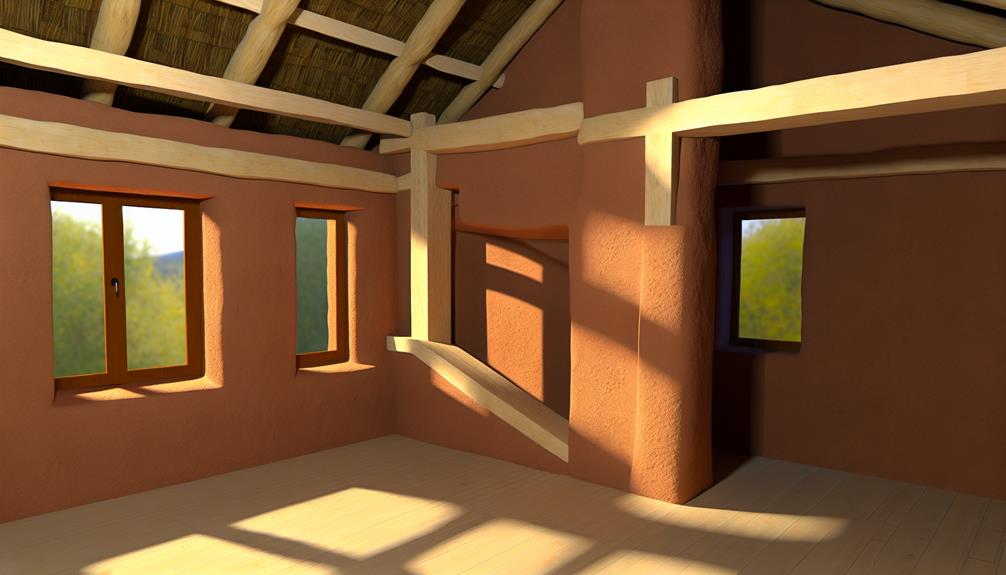
When considering eco-friendly options for insulation in modern house design, natural materials such as cork, hempcrete, and rammed earth provide excellent thermal properties and sustainability.
Cork, made from the bark of cork oak trees, is a renewable and mold-resistant material that offers exceptional insulation and acoustic properties. It's also a great choice for those seeking to reduce their carbon emissions.
Hempcrete, a mixture of hemp fibers and lime, is a lightweight and breathable material that provides high thermal insulation. Not only is hempcrete carbon-negative, but it also requires minimal energy during production.
Rammed earth, on the other hand, is a mixture of soil, gravel, and clay that's compacted into solid walls. This durable material offers excellent thermal mass and insulation, reducing the need for excessive heating and cooling.
Additionally, using natural insulation materials like cork, hempcrete, and rammed earth helps preserve natural resources and promotes an eco-friendly approach to building.
Eco-Friendly Flooring Choices
To continue your exploration of eco-friendly materials for modern house design, let's now turn our attention to the topic of eco-friendly flooring choices. When it comes to sustainable and eco-friendly flooring materials, there are several options available that can contribute to energy efficiency and reduce environmental impact.
Bamboo flooring is a popular choice for modern house design due to its sustainability. Bamboo is a fast-growing plant that reaches maturity in just a few years, making it a renewable resource. It's also durable and can withstand heavy foot traffic. Additionally, bamboo has minimal environmental impact during its production and installation.
Cork flooring is another eco-friendly option. Harvested from cork oak trees, cork is a renewable and biodegradable material. It offers excellent insulation, reducing energy consumption and improving the energy efficiency of green buildings. Cork is also resistant to moisture, making it suitable for areas prone to water exposure.
Hempcrete flooring is made from the woody core of hemp plants. This material provides excellent thermal insulation and is lightweight and breathable. Hempcrete is a sustainable choice, as hemp plants grow quickly and require minimal pesticides or herbicides.
Recycled steel flooring is a strong and durable option made from scrap metal. By using recycled steel, the need for virgin materials is reduced, contributing to sustainability. Furthermore, steel flooring can be recycled indefinitely, minimizing waste.
Lastly, reclaimed wood flooring is a sustainable alternative to traditional hardwood floors. Salvaged from old buildings or shipping pallets, reclaimed wood helps reduce deforestation and landfill waste. It adds character and warmth to modern house designs while being eco-friendly.
When choosing eco-friendly flooring materials for your modern house design, consider the sustainability and environmental impact of the materials. Opting for natural materials like bamboo, cork, hempcrete, recycled steel, or reclaimed wood can contribute to a greener and more sustainable home.
Innovative Green Building Technologies
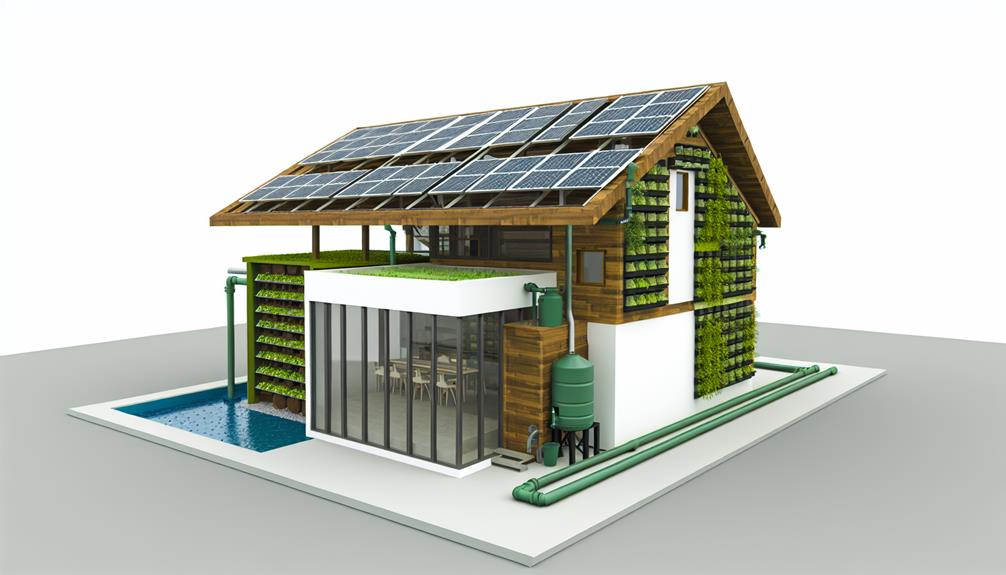
One of the most exciting advancements in sustainable construction is the use of innovative green building technologies. These technologies are revolutionizing the way we design and build modern homes, offering sustainable and eco-friendly materials that reduce our impact on the environment. By incorporating these new construction materials, we can create energy-efficient, carbon-neutral, and natural buildings that promote a greener way of living.
One example of an innovative green building technology is hempcrete. Made from the woody core of the hemp plant mixed with lime and water, hempcrete is a lightweight and breathable material that provides excellent thermal insulation. It also has the unique ability to absorb carbon dioxide during the curing process, making it a carbon-negative material.
Another green building technology is the use of recycled steel. This strong and durable material is made from scrap metal, reducing the need for virgin materials. Recycled steel can be used in structural elements, roofing, and cladding, making it a versatile and sustainable choice for modern house design.
Bamboo is another sustainable material that's gaining popularity in green home construction. This fast-growing and renewable resource has high tensile strength and durability, making it suitable for flooring, furniture, and even structural elements. Bamboo isn't only eco-friendly but also adds a touch of natural beauty to any home.
Cork insulation board is another innovative green building technology that offers excellent thermal and acoustic insulation properties. This renewable and biodegradable material is resistant to moisture, mold, and pests, making it perfect for walls, floors, and roofs.
Finally, prefabricated insulated panels are revolutionizing the construction industry. These factory-made panels have insulation sandwiched between layers, providing excellent thermal efficiency and airtightness. They reduce on-site construction time and waste, making them a sustainable choice for walls, roofs, and floors.
Incorporating these innovative green building technologies into modern house design not only helps us create more sustainable and eco-friendly homes but also reduces our energy consumption and carbon footprint. By choosing these construction materials, we can contribute to a greener future while still enjoying all the modern comforts of a well-designed home.
